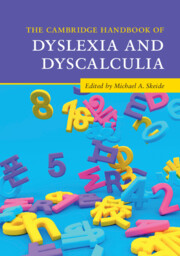Book contents
- The Cambridge Handbook of Dyslexia and Dyscalculia
- The Cambridge Handbook of Dyslexia and Dyscalculia
- Copyright page
- Contents
- Figures and Tables
- Contributors
- Acknowledgements
- General Introduction
- Part I Theoretical Frameworks and Computational Models
- Part II Cognitive Profiles and Behavioural Manifestations
- Part III Genetic and Environmental Influences
- Part IV Neurodevelopmental Foundations
- Part V Gender, Ethnicity, and Socioeconomic Background
- Part VI Cultural Unity and Diversity
- Part VII Early Prediction
- 17 Early Prediction of Learning Outcomes in Reading
- 18 Early Prediction of Learning Outcomes in Mathematics
- Summary: Early Prediction
- Part VIII Intervention and Compensation
- Part IX Best Practice – Diagnostics and Prevention
- Part X Best Practice – Schooling and Educational Policy
- General Summary
- References
- Index
- References
17 - Early Prediction of Learning Outcomes in Reading
from Part VII - Early Prediction
Published online by Cambridge University Press: 28 July 2022
- The Cambridge Handbook of Dyslexia and Dyscalculia
- The Cambridge Handbook of Dyslexia and Dyscalculia
- Copyright page
- Contents
- Figures and Tables
- Contributors
- Acknowledgements
- General Introduction
- Part I Theoretical Frameworks and Computational Models
- Part II Cognitive Profiles and Behavioural Manifestations
- Part III Genetic and Environmental Influences
- Part IV Neurodevelopmental Foundations
- Part V Gender, Ethnicity, and Socioeconomic Background
- Part VI Cultural Unity and Diversity
- Part VII Early Prediction
- 17 Early Prediction of Learning Outcomes in Reading
- 18 Early Prediction of Learning Outcomes in Mathematics
- Summary: Early Prediction
- Part VIII Intervention and Compensation
- Part IX Best Practice – Diagnostics and Prevention
- Part X Best Practice – Schooling and Educational Policy
- General Summary
- References
- Index
- References
Summary
This chapter focuses on the processes involved in the development of children’s decoding skills: the ability to translate printed words into a speech code, typically assessed by the accuracy and speed of reading aloud. If children struggle in developing this ability, they are often characterized as having dyslexia, but since decoding skills are normally distributed in the population, the cut-off for this diagnosis is somewhat arbitrary (Melby-Lervåg et al. 2012). During the first two years of school, the main aim for children is to develop accurate and fluent early reading abilities that will lay the foundation for the main goal of reading – to be able to extract meaning from text. Thus, though insufficient by itself, efficient word reading is, in turn, a necessary condition for the development of reading comprehension. Research on the foundations of learning to read has burgeoned in the last twenty-five years, with important theoretical and practical consequences.
- Type
- Chapter
- Information
- The Cambridge Handbook of Dyslexia and Dyscalculia , pp. 305 - 317Publisher: Cambridge University PressPrint publication year: 2022

